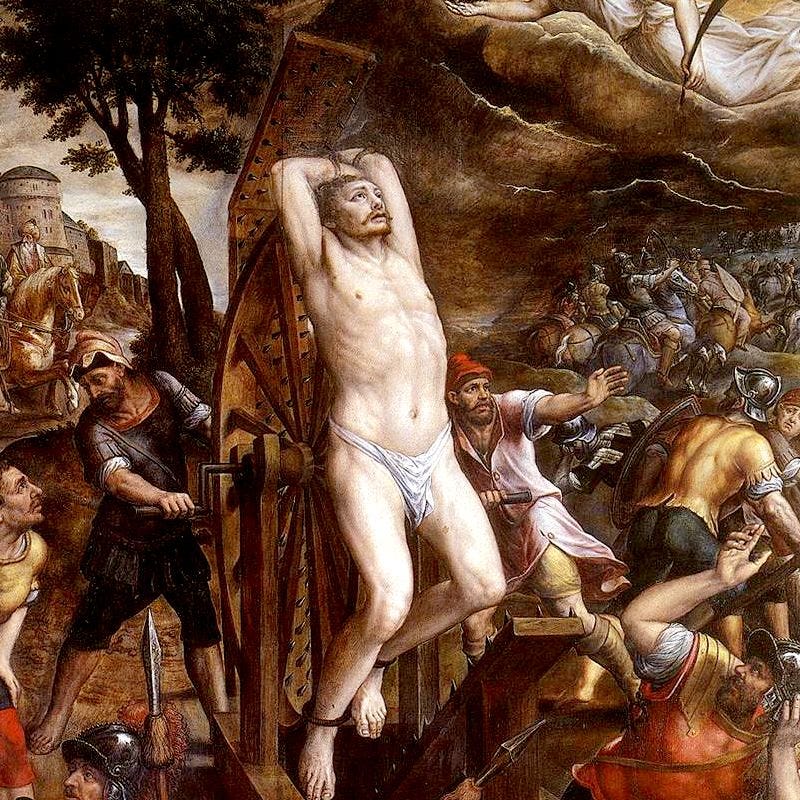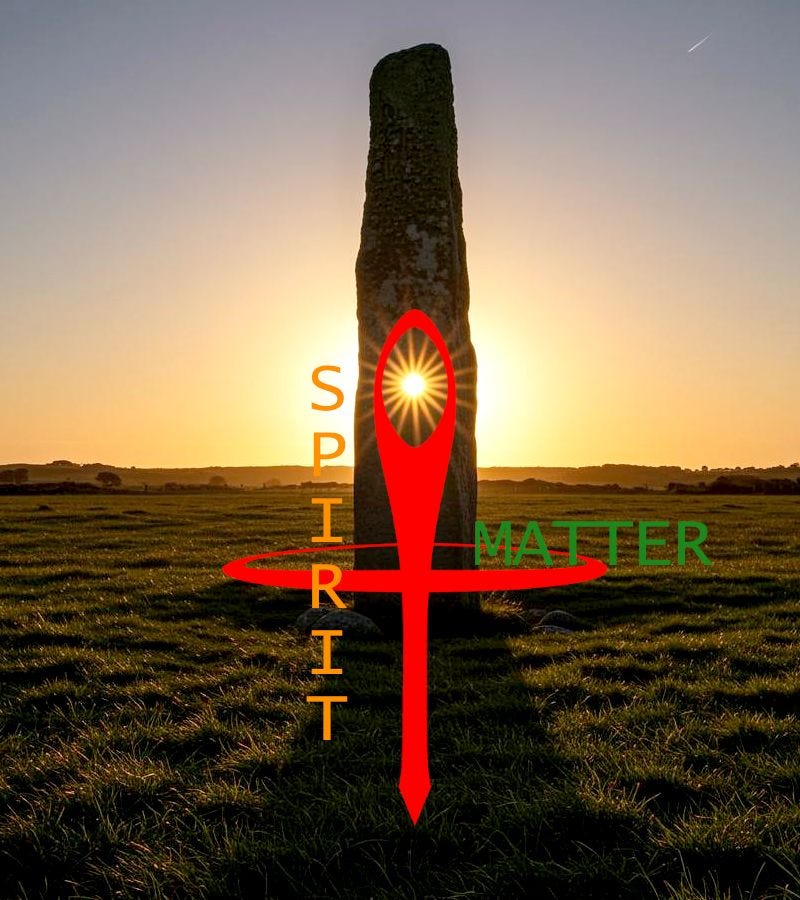St George, beyond the plastic veil
On the spirit of St George and the origin of the name Jorgensen; George's son.
This article was first published, by me, on my website. Obviously I have a personal interest in it, but it isn’t about me. It’s about a modern culture that hides the truth behind a plastic veil. It’s about the spirit, now downtrodden by a zombie society. And it’s about thinking about words, and what it means to be human.
Currently, Jorgensen is a common Scandinavian name, associated with Denmark, Norway, and less commonly, Sweden. The 'o' would normally be slashed, Ø, and has a different sound to 'O', being pronounced more like the 'u' in purr. As such, in some parts of the world, similar names are spelled Jurgensen, or using an o with an umlaut, ö. It's a patronymic, which means derived from the name of the father. Hence, Jorgen's son, or, son of Jorgen.
Jorgen is a name that has travelled from Ancient Greece, where it began as Georgios (Γεώργιος or Geōrgios); it is more common now to take the short form Giorgos (Yiorgos, Yorgos). Georgios is a compound formed from Ge and Ergon. Ergon, as in ergonomics, relates to the undertaking of a task, or work (metabolic effort rather than employment). Ge (γῆ) means earth, as in soil. It is the same root word that constitutes geo, as in geography, geological, and geometry (the art of measuring the earth).

So, George is the earth worker. A farmer, a market gardener, or a land worker. One who tills the soil. Sons of Cain, not Abel. Cain murdered Abel, and god marked him. Some say it's a physical mark. One suggestion for this mark is the Hebrew, Aramaic, and Phoenician letter vav, or waw. Vav is similar to an l or i, being straight up with a crook to the left. However, in early Hebrew it was more reminiscent of a y. Vav (often represented as a W) is the third letter of YHWH, a Hebrew name for god. Alone, it can represent the number 6, often considered to be the number of the human in Judaic mythology, which proposes that it was the sixth day upon which humankind was created (Saturday, the day of Saturn). Interestingly, vav is representative of the hook, peg (as in camping), and spear.
The mark of Cain, associated with the land worker, was linked to skin colour by the backwards religious types who sought to justify the enslavement of black Africans; people were put to work on the stolen territory of America. It’s been misappropriated for anti-Jewish purposes, too. However, the biblical translation of 'mark' is ambiguous, and is associated with sign, token, or seal. In biblical mythology, it is best considered a metaphor. Notably, all discussion on the matter leads to speculation.
In spiritual terms, the earth worker represents a metaphor for spirit in matter. The fallen angel, or star, come to earth to reside in a body, for a time. Thus, it rings its association with the cross of St George, where the vertical is the spirit coming down, and the horizontal is matter. St George is a cult figure across the globe. Patron of Hungary, Armenia, Lithuania, Portugal, Ethiopia, Moldova, Catalonia, Palestine, Greece, and many others. Interestingly, George, the earth worker (and descendant of Cain), is often depicted as slaying a dragon with a spear (remember vav — the spear?).
The historical figure of George, associated with the Saint, was said to be a man born in Cappadocia (modern Turkey), and who later immigrated to Palestine, where he served in the armed forces of the late Roman Empire. In 303 AD, the beast of Rome began a great persecution of Christians including burning scripture, depriving Christians of rights, and forcing them to engage in sacrificial practices. The story of George is rooted in his refusal to give up his faith. Rather than sacrifice his heart, he publicly declaimed the Roman persecution, and was brutally tortured and murdered. St George was later misappropriated as the spearhead of the crusades, an attempt at the violent extermination of Islam. This was not what St George represented.
The spear of destiny was the object used to confirm that Jesus' body was dead. When he was pierced in the side, blood and water flowed. This is a sign of death, as the blood separates from the plasma. However, its true meaning is as a symbol of the separation of spirit from matter. Similarly, the spear of St George was his will. His adherence to spirit over matter was the courageous lion of his heart, not his might. The dragon he slayed was the biological drive to survive. Rather than adapt by selling his soul, he retained belief in the primacy of the non-material realm, and released the urge to grasp at material gain.
Many other Christians did the same as George, suffering brutal deaths at the hands of the profane Roman Empire. So many, that the tyrant, Rome, eventually changed course, and adopted the Christian religion. However, with so many of the original scriptures and practices destroyed, they fused it with pagan religion to serve their ends. Defaming, and destroying, any surviving texts that they could not interpret favourably.

Modern Christianity retains this fusion with pagan ritual, including the drinking of blood, and the winter festival of Saturnalia. They are paganistic celebrations of physical sacrifice, and a reification of the material. A direct inversion of what many early Christian gnostics believed; namely, that the creator of the material world was an evil, and misguided, imposter. (Interestingly, the symbol for the dwarf planet, Ceres, is a cross formed with a sickle. A sickle being a sort of hooked spear. Ceres was also the Roman goddess of agriculture.)
So, understanding the root of Jorgensen, as with many other names, involves deep historical contemplation. Jorgen's son is the conscientious soul, come to work matter with spirit, to sacrifice his blood, not that of others, rather than submit to the dragon of earthly desire. It's a challenging task to give it due honour.
Origin of the name Peter, the rock, and the Egyptian first cause
Peter is derived from Ancient Greek, too. Πέτρος, or petros is a masculine form of petra, which means rock, or stone. More generally, a very hard thing. As in, petrified — turned to stone. It was petrus in Latin, but the etymological link can be traced back to Aramaic, kefa / kepha. Kefa, gave rise to the biblical name Cephas, which is believed to be the name that Jesus gave to Simon (Peter).
While evidence of the following appears to be absent from academic thought, it would be hard not to make a link between kepha and kephali (κεφαλή), which is Greek for head. Heads being quite hard, and round, due to the skull. Almost rock-like, you could say. Kephali, of course, being the root word for encephalitis, inflammation in the head (of the brain). The divine link to the name Peter is associated with hard rock, as this is a foundational element. In matter, rock is useful for building on due to its stability. So, it's easy to see how the unmoving, unchanging, preeminent factor, that gives rise to phenomenological reality, could be associated with rock. This might go further than naming a founding member of the Christian church, but to Egypt.
There's also no academic evidence of a connection between Peter, the rock, and Ptah, the Egyptian god. It's a link that sends some historical linguists into a raging froth. However, I find it takes unnatural effort to prevent the brain from connecting the two. Clearly there was intermingling between Aramaic, Greek, and Egyptian cultures, enabled by their geographic proximity. Also, the sound is similar. However, there's a deeper link. Aside from the Egyptians having quite a penchant for rock, especially piling it up in an incredibly creative, and robust manner. Their god, Ptah, was also the first cause. The one that birthed itself. Also known as the sculptor, or, dare I suggest, the stonemason? The everlasting, unmoving, creator of all. Do you see how this could link to petra? And to kepha? The head. The rock of the skull. The cave of creation. The place in which the experiential phenomena of all that exists for you is conjured.

If I didn't lose you, you'll see now that Peter Jorgensen is a name that could be interpreted to mean something along the lines of 'the rock gardener', or 'the reliable farmworker'. However, and more poetically, a deeper excavation could produce, 'the eternal spirit that entered a body to work within the changing material world, for a while.' I guess it's all a matter of what you find most inspiring.




